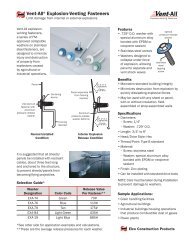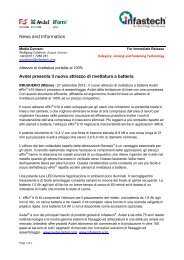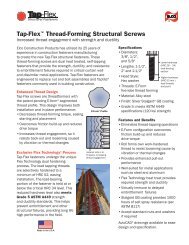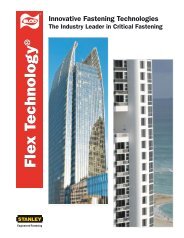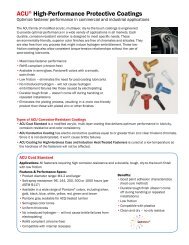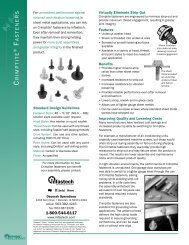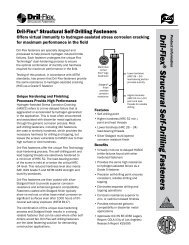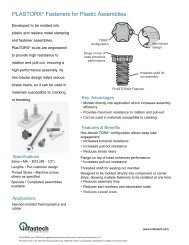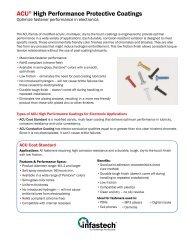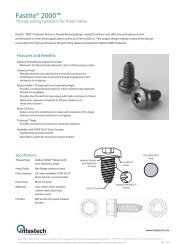Threaded Fasteners for plastic - Infastech
Threaded Fasteners for plastic - Infastech
Threaded Fasteners for plastic - Infastech
Create successful ePaper yourself
Turn your PDF publications into a flip-book with our unique Google optimized e-Paper software.
g l o s s a r y<br />
BOSS: Protuberance on a <strong>plastic</strong> part designed to add strength<br />
and/or facilitate fastening or alignment.<br />
CREEP: Permanent de<strong>for</strong>mation of a material caused by time,<br />
temperature and pressure.<br />
DRAFT ANGLE: The amount of slope in the boss<br />
hole and/or outside edge, measured from a line<br />
perpendicular to the bottom of the boss.<br />
FILLERS: Additives or rein<strong>for</strong>cements that are<br />
added to a polymer to change one or more of its<br />
characteristics such as strength, wear resistance,<br />
etc.<br />
FLANK ANGLE: See thread profile.<br />
HELIX ANGLE: The angle between the helix of the<br />
thread and a line perpendicular to the axis of<br />
the screw.<br />
LEAD THREAD: The thread length from where<br />
it starts to where it becomes full size. This<br />
distance is usually one-half the fastener<br />
diameter.<br />
LENGTH OF ENGAGEMENT: The length of full-sized fastener<br />
threads that engage in the nut material.<br />
The length of the lead thread is not<br />
counted in the length of engagement,<br />
since its reduced size minimizes any<br />
per<strong>for</strong>mance benefits. The length of<br />
engagement is usually expressed in<br />
relationship to the nominal diameter of the<br />
screw (e.g. 2 to 2-1/2 diameters of<br />
engagement).<br />
MAJOR DIAMETER: The outside or largest<br />
diameter of an external thread.<br />
MINOR DIAMETER: The inside or smallest<br />
diameter of an external thread.<br />
NOMINAL DIAMETER: The major diameter<br />
of a screw or, in tri-round fasteners, the “C”<br />
dimension.<br />
PEAK DRIVE TORQUE: Amount of <strong>for</strong>ce<br />
required to pull the members of a joint together; the point at<br />
which clamp begins to generate.<br />
34<br />
length of<br />
eng.<br />
lead<br />
thread<br />
MØ<br />
mØ<br />
draft angle<br />
helix<br />
helix angle<br />
RADIAL STRESS (hoop stress): Forces<br />
that propagate from the screw towards<br />
the outside diameter of the boss.<br />
SHEAR: Force that tends to divide an<br />
object along a plane parallel to the<br />
opposing stresses.<br />
THERMOPLASTIC: These widely used<br />
polymers are characterized by their<br />
ductility (fillers may be added to<br />
increase stiffness). Thermo<strong>plastic</strong>s can<br />
be remelted and re<strong>for</strong>med several times<br />
without degrading the material.<br />
THERMOSET: These polymers are<br />
characterized by extreme stiffness. The<br />
initial molding process causes a<br />
chemical reaction which “cures” the<br />
material, so the resin cannot be<br />
reprocessed.<br />
THREAD ENGAGEMENT: The amount of<br />
thread tooth that is filled<br />
by the application<br />
material. This<br />
measurement is usually<br />
expressed as a<br />
percentage and is used<br />
to determine optimal<br />
hole size.<br />
THREAD PROFILE: The<br />
angle between the<br />
flank of the thread and<br />
a line perpendicular to<br />
the screw axis.<br />
flank<br />
ULTIMATE TORQUE: The amount of<br />
<strong>for</strong>ce at which a fastener begins to strip<br />
or otherwise fail in a joint.



